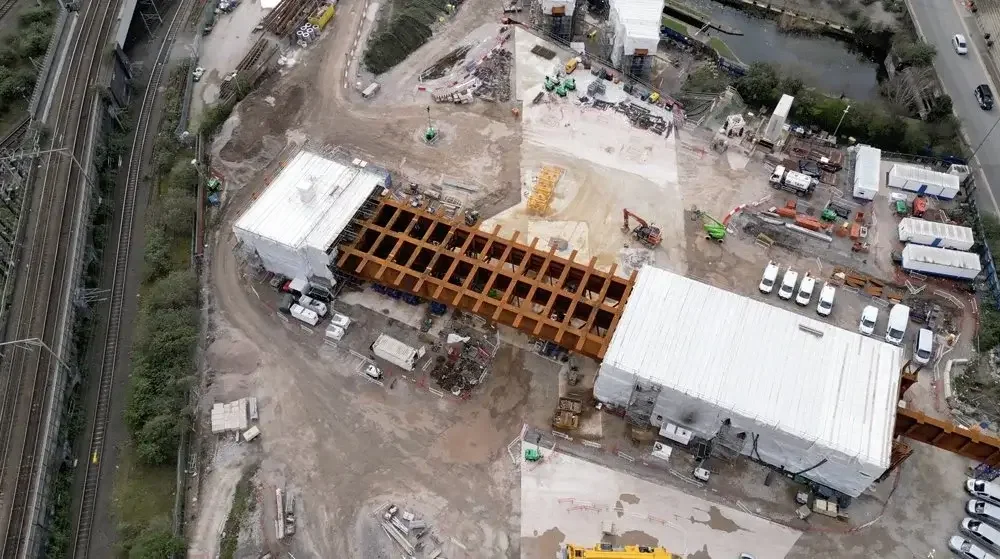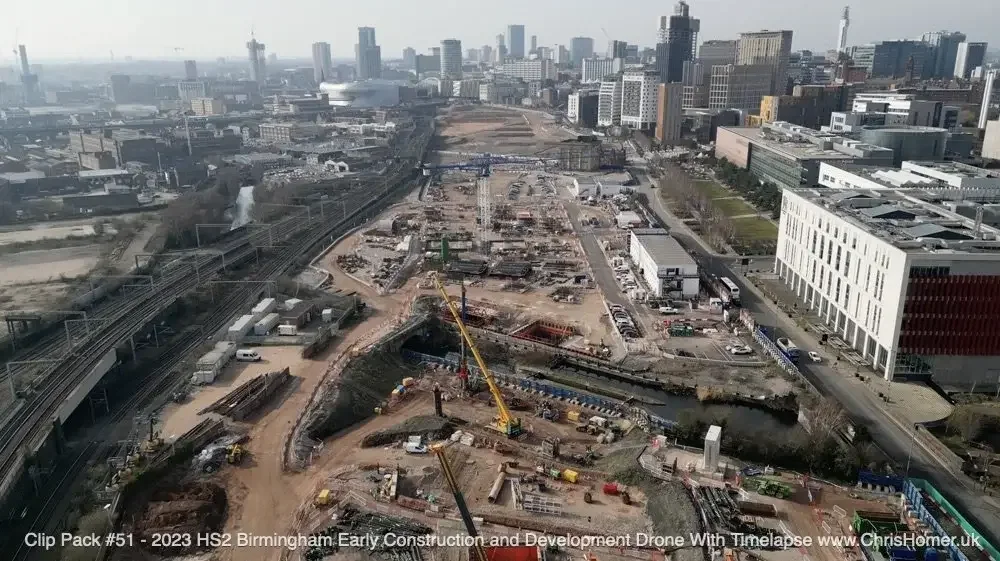High Speed 2 (HS2) Construction and Development in Birmingham - Aerial Images and Video
A unique collection of aerial images and video of the construction and development of High Speed 2 (HS2) in Birmingham.
This collection includes 32 premium 4K drone video footage clips (18 minutes and 59 seconds, 7.4GB), capturing the ongoing development of the HS2 high-speed rail project in Birmingham, West Midlands. This pack is ideal for use in documentaries, news coverage, infrastructure-focused projects, and urban development narratives.
Key Features
Construction and Engineering
Wide aerial views and top-down shots of the HS2 construction site, highlighting its scale and complexity.
Steel frames, tunnels, cranes, and earth-moving machinery in action.
Workers onsite, offering insight into the human effort behind this monumental infrastructure project.
Landmarks and Context
Footage of the new Curzon Street Station under construction, a centerpiece of the HS2 project.
Passing trains at Birmingham Moor Street and Grand Central stations, connecting the project to the city’s transport hub.
Birmingham city center in the background, featuring iconic landmarks like the Bullring, Selfridges, and the city skyline.
This pack provides a detailed and visually striking overview of HS2’s progress, blending technical construction imagery with the vibrant backdrop of Birmingham, making it a perfect choice for showcasing the future of UK rail infrastructure.
This collection of 28 clips (13 minutes 10 seconds, 7.26GB) showcases the ongoing development of the HS2 high-speed rail project in Birmingham from February and March 2023. The footage includes stunning aerial views of the Curzon Street station site, Birmingham's city centre, the Bullring shopping centre, and Grand Central railway station. The pack features a range of construction activities, such as the use of diggers, cranes, earth-moving machinery, steel work, tunnels, and general site development.
Additionally, three premium drone timelapse sequences captured in ProRes422 quality offer an incredible look at the busy construction site, with moving machinery, cars, trains, and the dynamic Birmingham skyline in the background. This exclusive footage provides an exceptional perspective on the early stages of the HS2 project, perfect for high-quality documentary, infrastructure, and urban development projects.
I’m regularly adding content to the HS2 railway collection, please contact me for anything in particular. Here’s an overview of what’s available…
This low aerial view of HS2 railway development in Birmingham slides from left to right with a passing train on the rail in the foreground, and Millenium Point and the city centre in the background. The old Curzon Street railway station building stands proud amongst the construction. This video is available as stock footage HERE.
This incredible aerial view of HS2 development in Birmingham offers a busy development scene set in front of a growing cityscape under a blue sky. Trains pass through the foreground, leading the eye towards Moor Street Station and the Bullring. Avaailble exclusively HERE.
The collection offers a unique perspective, with a variety of angles of the HS2 construction process. LINK
A high wide orbiting aerial shot of the Curzon Street construction area of HS2 in Birmingham. LINK
VISIT THE FULL HS2 CONSTRUCTION COLLECTION
Archived HS2 Footage
In addition to the exclusive HS2 collection above, I also have available an old archived collection of HS2 shots here, in the ARCHIVED HS2 COLLECTION.
Amongst this content is this footage of the Curzon Street area of Birmingham from before HS2 development began, a truly unique perspective of Birmingham.
More about HS2 in Birmingham
High Speed 2 (HS2) is a major high-speed railway project that aims to connect London, Birmingham, Manchester, and Leeds, with the aim of improving connectivity, reducing travel times, and supporting economic growth in the UK. The project has been in development for several years and is expected to be completed in phases, with the first phase focusing on the London to Birmingham route.
Birmingham is one of the key cities that will benefit from the HS2 project, as it is a major economic centre and transportation hub in the UK. The construction and development of HS2 in Birmingham have been a significant undertaking, involving a range of stakeholders, including the government, local authorities, and private contractors.
The development of HS2 in Birmingham has involved several key stages, including planning, design, and construction. The planning stage involved extensive consultation with local communities, businesses, and stakeholders to ensure that the project met their needs and priorities. The design stage involved developing detailed plans for the railway, including the alignment, station design, and other key features.
Construction of HS2 in Birmingham has involved a range of activities, including land acquisition, site preparation, and the construction of various infrastructure and facilities. One of the key components of the project has been the construction of the Curzon Street station, which will be the main station for HS2 in Birmingham. The station has been designed to be an iconic gateway to the city, featuring a unique curved roof and a range of sustainable features.
In addition to the construction of the Curzon Street station, the HS2 project in Birmingham has involved the construction of several other key infrastructure components. These include the construction of a viaduct to carry the railway over the River Tame, the construction of several tunnels to reduce the impact of the railway on local communities, and the construction of various bridges, embankments, and other structures.
The development of HS2 in Birmingham has not been without controversy, with some local communities and environmental groups expressing concerns about the impact of the project on the local environment and communities. However, supporters of the project argue that HS2 will bring significant economic benefits to the region, including improved connectivity, increased investment, and job creation.
Overall, the construction and development of HS2 in Birmingham is a major undertaking that is expected to have significant benefits for the region and the UK as a whole. While there are certainly challenges and concerns associated with the project, it represents a major investment in the future of the UK's transportation infrastructure, and has the potential to support economic growth and development for decades to come.
HS2 Problems
The project has faced significant criticism and controversy due to various issues, including:
Cost: HS2 is one of the most expensive infrastructure projects in the UK, with an estimated cost of over £100 billion. The high cost has been a point of contention, with critics arguing that the money could be better spent on other projects that would have a more significant impact on the economy and society.
Environmental impact: The construction of HS2 is expected to cause significant environmental damage. The project will involve the destruction of wildlife habitats and ancient woodlands, which has led to protests and legal challenges from environmental campaigners.
Disruption to communities: HS2 will run through many residential areas, and construction work is expected to cause significant disruption to local communities. Some residents have already been forced to leave their homes due to the project, and others are concerned about the impact of the railway on their quality of life.
Economic benefits: While supporters of HS2 argue that it will bring significant economic benefits to the UK, including job creation and increased investment, critics question whether the project will deliver the promised benefits. Some argue that the economic case for HS2 is weak, and that the money would be better spent on other projects that would have a more significant impact on the economy.
Alternatives: Some critics of HS2 argue that there are better alternatives, such as upgrading existing railway lines and investing in other forms of transport, such as buses and cycling infrastructure. They argue that these alternatives would be more cost-effective and less damaging to the environment and local communities.
While there are arguments in favour of HS2, the project has faced significant criticism and controversy due to its high cost, environmental impact, disruption to communities, and questions about its economic benefits.
More about Curzon Street
Curzon Street is a historic street located in the heart of Birmingham, England. This street is considered to be one of the oldest streets in the city and is known for its unique architecture and historical significance.
The street was named after George Nathaniel Curzon, who was the Viceroy of India from 1899 to 1905. During his tenure as Viceroy, he helped to develop and modernize India, and his name was given to this street as a tribute to his contributions.
Curzon Street is home to several historic buildings, including the Curzon Street Station, which was the original terminus of the London and Birmingham Railway. The station was built in 1838 and was designed by Philip Hardwick. It was the first railway station in the world to be built in a city centre and is considered to be one of the most important railway stations in the world.
Another notable building on Curzon Street is the Curzon Hall, which is a Grade II listed building that was built in 1903. The building was designed by Thomas Cecil Howitt and is now used as a conference and events venue.
In recent years, Curzon Street has undergone a significant transformation as part of the HS2 high-speed rail project. The project involves the construction of a new high-speed rail line that will link London and Birmingham. The new line will pass through Curzon Street, and a new railway station will be built on the site of the old Curzon Street Station.
The new Curzon Street Station will be a modern and sustainable building that will be designed to reflect the history and heritage of the street. It will feature state-of-the-art facilities, including shops, restaurants, and cafes, and will provide a gateway to the rest of the city.
ICurzon Street is a historic street that has played an important role in the development of Birmingham. With the construction of the new Curzon Street Station, the street is set to continue its legacy as a hub of innovation, progress, and growth.




